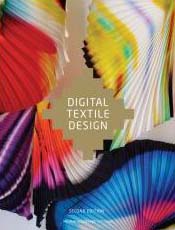Digital Textile Design Second Edition
Melanie Bowles and Ceri Isaac
Laurence King
ISBN - 978 1 78067 002 7
Paperback £22.50
October 2012
And now for something completely different – a book review. Although this is a papercraft blog, textile design is not off-subject, as you might at first think. You can apply the practical skills and abundant inspiration offered by the above title to create scrapbooking papers and engineered designs for papercrafting. Transferable skills!
Print design has always fascinated me. I studied Textile Design in pre-digital times. Pattern repeats were cut-and-paste jobs and colourways were individually handpainted. Labour-intensive and time-consuming. Digital advances have revolutionized textile design. Not only are there computer-based techniques and resources for generating designs, there are new manufacturing methods (some of which, like short runs on digital inkjet printers, are affordable and accessible to the individual designer). These digital methods accelerate productivity and fuel creative innovation, which is why Digital Textile Design, first published in 2009, is on its second edition.
The digital textile scene is an exciting place to be – and the authors of this book are leaders in the field. Melanie Bowles is a senior lecturer in Digital Textiles Design at Chelsea College of Art and Design, University of the Arts, London. She is also a textile designer and researcher. Ceri Isaac designs digital textiles. Their book surveys the current digital textile scene, discussing the application of technological advances, showcasing the work of individual designers, and providing practical know-how.
 |
| Detail of a digi flower fantasy print by author, Melanie Bowles. |
Even if you are not a design student or professional, this lavish book has much to offer in the way of design inspiration and how-to info. The step-by-step design tutorials guide you through the mechanics of textile design using the industry-standard programs of Adobe Photoshop and Illustrator. There is much to learn about textile design principles, even if you do not have access to these programs. If you are a weekend crafter, for example, you might have Photoshop Elements or Paint, which are similar in many ways.
Designer profiles are an important part of this book – and they add warmth and personal interest to the mix.
This book might encourage you to try something new in your crafting – say, using a pen tablet, or making greater use of your scanner. There is a chapter on digital craft, which highlights a variety of hybrid projects – embellishing digital projects with handcrafted elements. (This idea has great appeal for papercrafters.) Perhaps you will be encouraged to add a photographic element to one of your projects – or to try to design a simple repeating pattern on your computer. ...Or maybe you just want to gain an insight into the process of computer-assisted pattern design. Take a look at this beautifully-produced book that fizzes with enthusiasm and creativity.


Its amazing where you can draw inspiration from. Thanks for drawing my attention to the book x
ReplyDeleteThanks, Nadine. Yes, textile design is one big crafty adventure. I hope you'll be seeing some pattern-embellished projects on the blog soon (if I do my digital homework...)
DeleteBest,
Susan